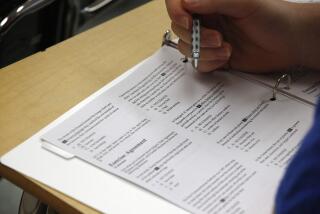What Rankings Really Do
- Share via
The much-maligned annual rankings of colleges and universities by U.S. News & World Report turn out to be meaningful after all -- as self-perpetuating popularity contests.
The rankings do little to measure the actual quality of a school’s education, but they are fairly accurate predictors of how easily a college can raise money and attract top students and corporate recruiters. To colleges, and to many students and their ambitious parents, that’s very meaningful and may even contribute in the end to improving education at a school. Just maybe.
The amusing thing about the ranking process is watching college administrators complain about it, while going to great lengths to climb the U.S. News ladder. It’s not unlike a politician who claims not to care about polls, or some teenagers who claim not to care about getting invited to the right party. Amusingly, the deans of almost every law school accredited by the American Bar Assn. signed a letter a few years ago urging applicants to ignore the rankings, while the schools continued to send their data to the magazine.
The influence of the rankings isn’t always a bad thing. For decades, law schools gave extra consideration to applicants from the most competitive undergraduate schools. In recent years, some schools have been backing off from this policy and putting full weight into grades and standardized test scores. The reason, in part, is that U.S. News counts those two factors when ranking law schools, but not whether applicants came from brand-name undergraduate colleges. It’s a boon to lesser-known schools and their students, though few know about it. So, perversely, grad schools can improve their rankings by ignoring the college rankings.
The magazine relies on a survey of college officials, asking them to rate schools in their category, although 40% don’t fill it out and many may strategically downgrade rivals. It also uses SAT scores, which some colleges manipulate by not reporting all scores. It counts money spent per student, although that might reflect large sums for athletics or administration rather than academics. It counts the acceptance rate, so, to seem more selective, colleges do heavy recruiting among students they know they won’t accept.
Many college administrators allow the rankings to set their agenda, and it’s hard to blame them if type-A high school seniors (or parents, we hasten to add) allow these subjective rankings to drive their decision upon receiving their April letters. For the magazine’s rankings to fulfill their real mission of valuing colleges as if they were stocks, maybe they should quantify families’ return on investment. How much are those Stanford grads making 25 years down the road?
Of course, Stanford had its spell of bashing the rankings under a former president, and the president of Mount Holyoke published a screed against the rankings, but they still participate. They hate it -- but they just ... can’t ... leave it.
Then there’s iconoclastic Reed College in Oregon, which a decade ago stopped participating in the ranking process. Once listed by U.S. News among the top 10 liberal arts colleges, it’s now 50-something, largely because the magazine has changed its ranking system and because it cannot get some statistics without Reed’s cooperation. The college, though, appears undamaged; its student SAT scores are high and rising, the number of applicants growing. Credit Reed with a brilliant marketing ploy -- raising its profile by shunning marketing.







